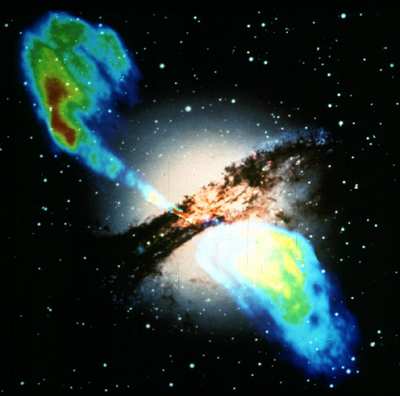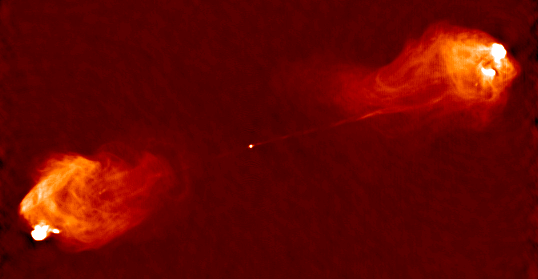AGN jets
What is this all about?
Extragalactic jets emerge from active nuclei of massive elliptical galaxies and are present over a wide range of distances - from Centaurus A in the local universe at a distance of 4 Mpc (1 pc = 3.26 light years) to radio galaxies in the early universe at redshifts of z > 5 (that means, the light from these galaxies travelled to us for more than 12 billion years). The energy release associated with these objects is enormous and can exceed 1040 watts. This power is believed to be released near supermassive black holes with masses up to 1010 solar masses. The jets are bipolar plasma streams with speeds close to the speed of light, which are probably launched by hydromagnetic processes near the accretion disks around these black holes or by electromagnetic extraction of angular momentum from the black hole. They extend over many orders of magnitude in length, observed from several hundred Schwarzschild radii (less than 10-3 pc) to the 106 pc scale, and thus propagate far into the surrounding galaxy cluster medium.
 Overlay of the Centaurus A galaxy with the prominent dust lanes and the emerging jet.
(optical and radio image (VLA 6 cm),
STScI/NASA)
Overlay of the Centaurus A galaxy with the prominent dust lanes and the emerging jet.
(optical and radio image (VLA 6 cm),
STScI/NASA)
We are especially interested in the interaction of the jet with this intracluster medium on the scale of hundreds of kiloparsecs, which is a length scale that is typically observed for the high-power FR II jets in a wide spectral range from radio to X-rays. These jets are visible only due to motion of relativistic electrons in magnetic fields as synchrotron radiation in radio frequencies (for other frequency ranges this may also be true, but is still under debate). Thus we try to simulate these jets including magnetic fields to be able to explain several observed properties as their emission properties and the cocoon shape.
Extragalactic jets are assumed to be much lighter than their ambient gas, which makes it very hard for the jet to propagate due to its little momentum. A rough estimate of the propagation speed can be found from momentum balance with a constant working surface, which yields a speed decreasing with the density contrast between jet and ambient matter. This leads to a very slow motion of the jet head, where the fast jet plasma hits the external medium in the so-called hotspots. To reach the observed sizes and agree with statistical analyses, the black hole activity has to last for tens of millions of years. This long time makes it impossible to run the simulations on usual workstations - it would take years - and the use of supercomputers is the only way for numerical studies.
While there are many detailed observations of extragalactic jets, even the most basic parameters of these jets, as density, Mach number and the composition of the plasma, are very hard to constrain. This make simulations difficult and enforces setups with several different parameters. Most simulations in the literature assumed less extreme density contrasts to allow for reasonable jet sizes. We try to use more realistic density contrasts because previous work in this project (Krause 2003) showed that these very light jets show a different behaviour than their heavier counterparts.
 The jets of Cygnus A (3C 405), 4.8 GHz VLA map courtesy of C. Carilli.
The jets of Cygnus A (3C 405), 4.8 GHz VLA map courtesy of C. Carilli.
Additionally, current observations suggest equipartition magnetic fields in jet cocoons, which makes a magnetohydrodynamical treatment of these objects necessary, even when one assumes somewhat weaker magnetic fields. Here we will concentrate on the morphological properties of very light jets, which may show a way towards a more precise determination of the jet parameters.
